Abstract
The influences of Gaeumannomyces graminis var. tritici (which causes take-all of wheat), Rhizoctonia solani AG-8 (which causes rhizoctonia root rot of wheat), Pythium irregulare, P. aristosporum, and P. ultimum var. sporangiiferum (which cause pythium root rot of wheat) on the population dynamics of Pseudomonas fluorescens 2-79 and Q72a-80 (bicontrol strains active against take-all and pythium root rot of wheat, respectively) in the wheat rhizosphere were examined. Root infection by either G. graminis var. tritici or R. solani resulted in populations of both bacterial strains that were equal to or significantly larger than their respective populations maintained on roots in the absence of these pathogens. In contrast, the population of strain 2-79 was significantly smaller on roots in the presence of any of the three Pythium species than on noninfected roots and was often below the limits of detection (50 CFU/cm of root) on Pythium-infected roots after 40 days of plant growth. In the presence of either P. aristosporum or P. ultimum var. sporangiiferum, the decline in the population of Q72a-80 was similar to that observed on noninfected roots; however, the population of this strain declined more rapidly on roots infected by P. irregulare than on noninfected roots. Application of metalaxyl (which is selectively inhibitory to Pythium spp.) to soil naturally infestated with Pythium spp. resulted in significantly larger rhizosphere populations of the introduced bacteria over time than on plants grown in the same soil without metalaxyl. It is apparent that root infections by fungal pathogens may either enhance or depress the population of fluorescent pseudomonads introduced for their control, with different strains of pseudomonads reacting differentially to different genera and species of the root pathogens.
Full text
PDF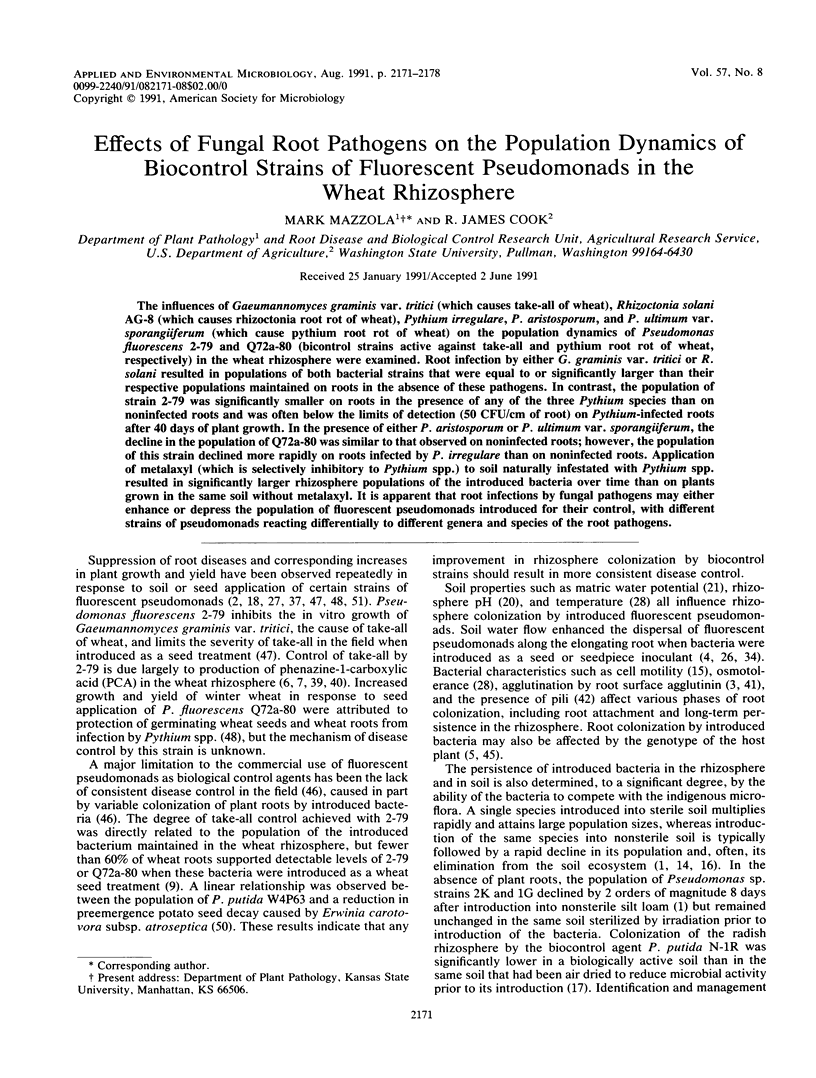
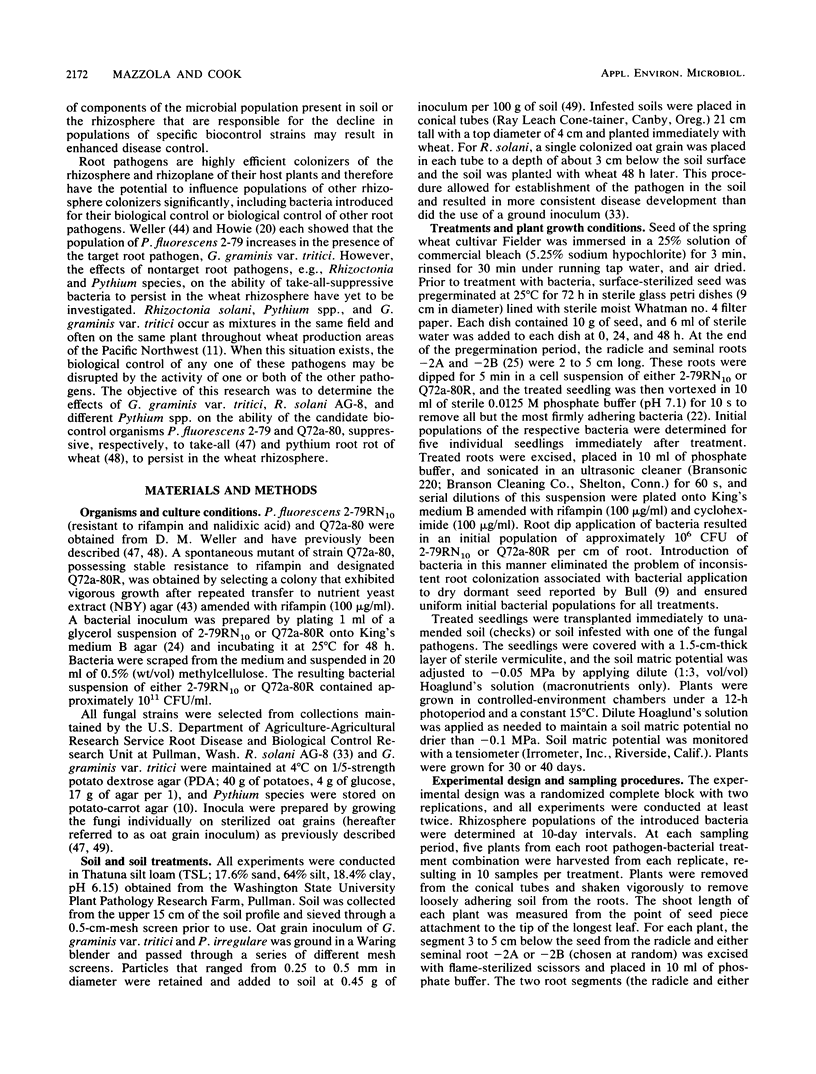
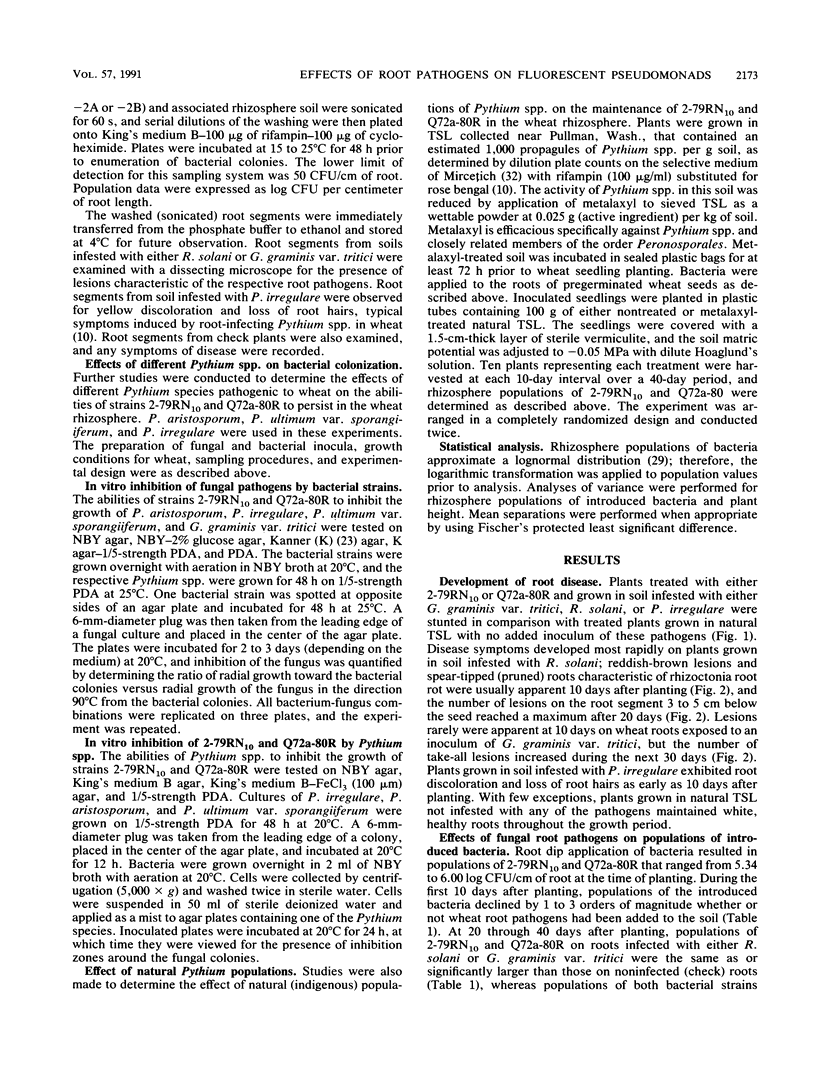
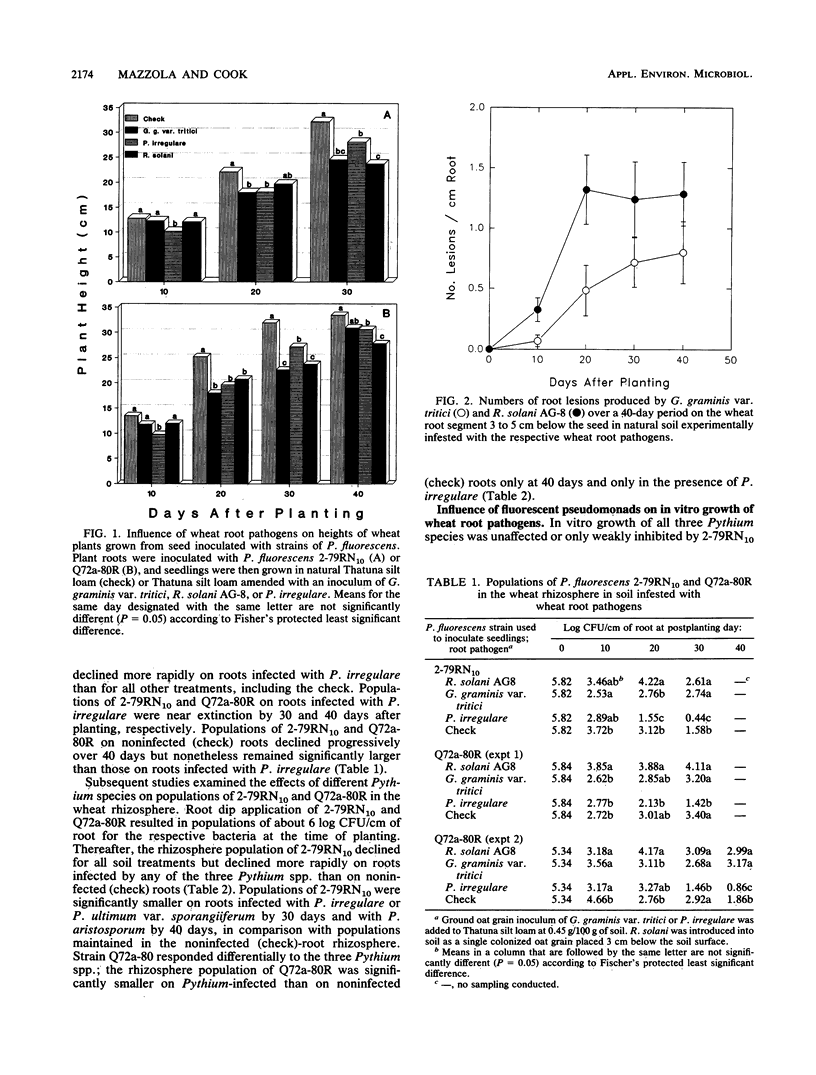
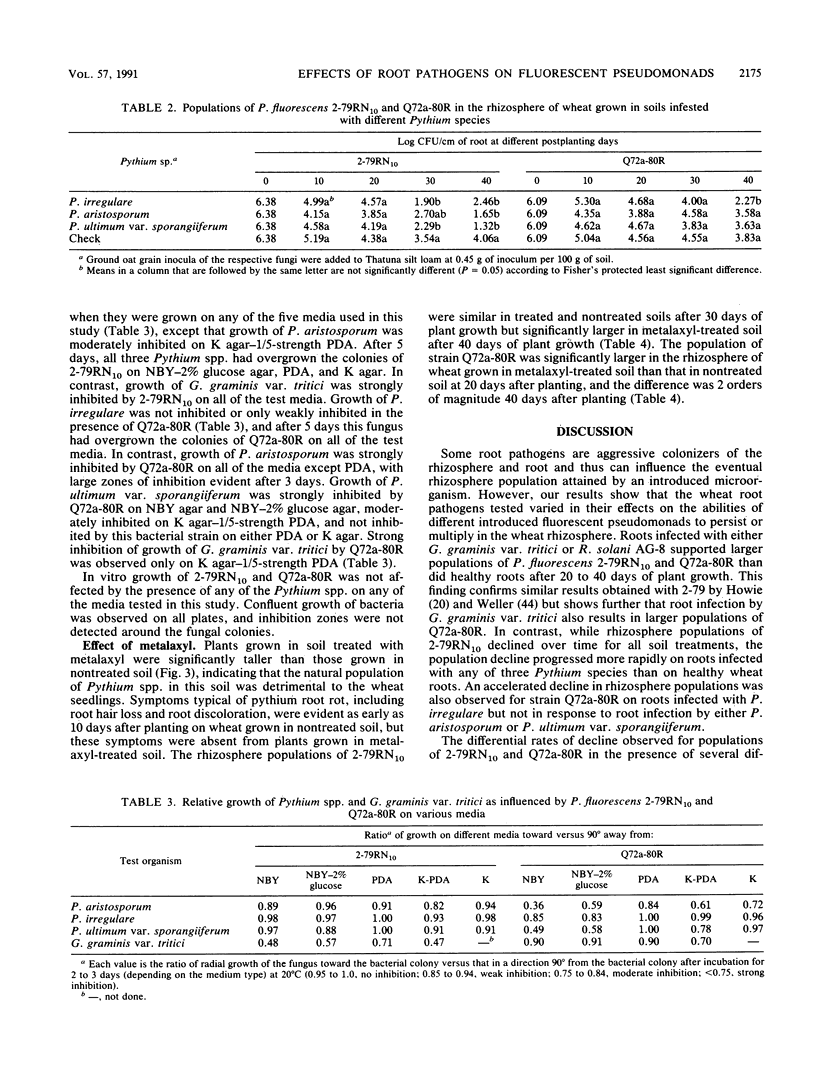
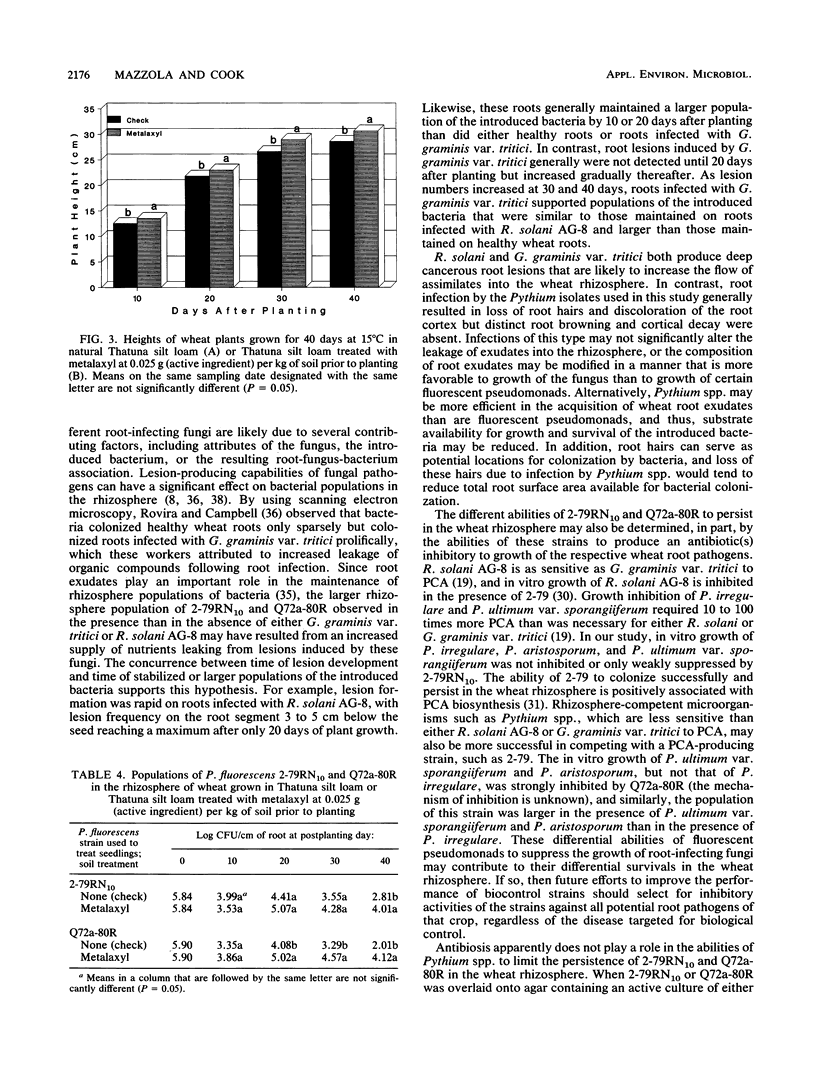

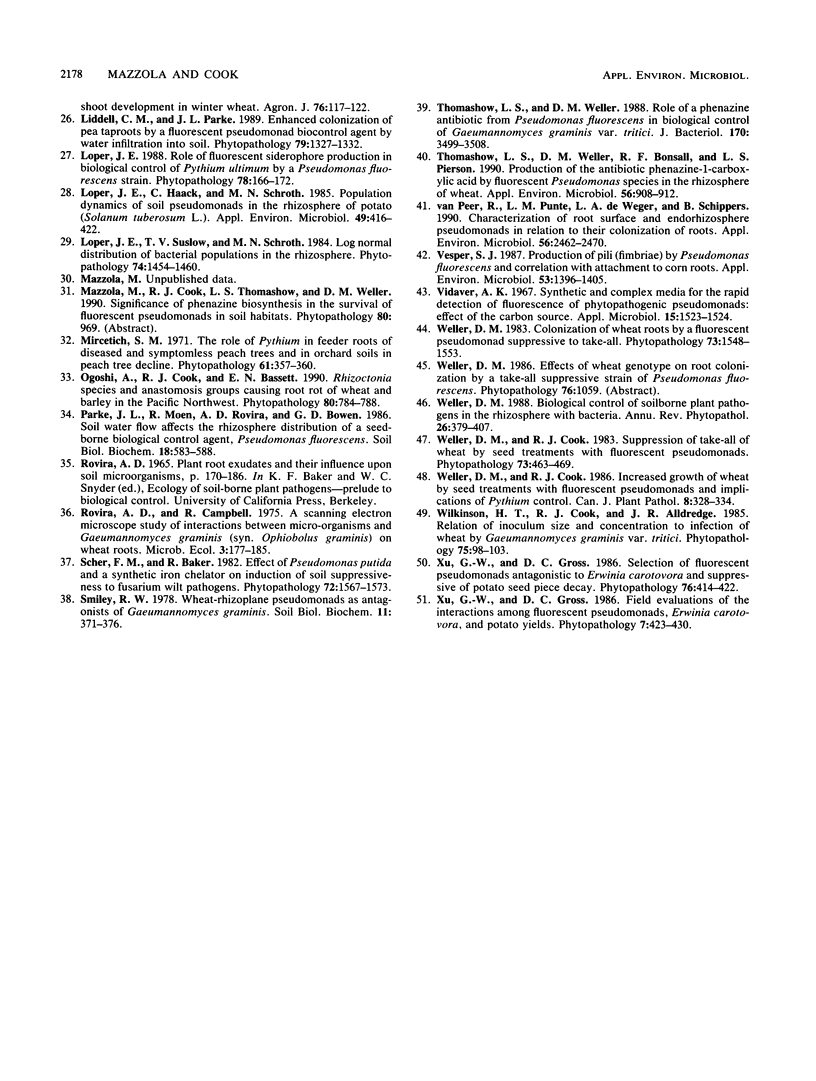
Selected References
These references are in PubMed. This may not be the complete list of references from this article.
- Anderson A. J., Habibzadegah-Tari P., Tepper C. S. Molecular Studies on the Role of a Root Surface Agglutinin in Adherence and Colonization by Pseudomonas putida. Appl Environ Microbiol. 1988 Feb;54(2):375–380. doi: 10.1128/aem.54.2.375-380.1988. [DOI] [PMC free article] [PubMed] [Google Scholar]
- Brisbane P. G., Janik L. J., Tate M. E., Warren R. F. Revised structure for the phenazine antibiotic from Pseudomonas fluorescens 2-79 (NRRL B-15132). Antimicrob Agents Chemother. 1987 Dec;31(12):1967–1971. doi: 10.1128/aac.31.12.1967. [DOI] [PMC free article] [PubMed] [Google Scholar]
- Danso S. K., Keya S. O., Alexander M. Protozoa and the decline of Rhizobium populations added to soil. Can J Microbiol. 1975 Jun;21(6):884–895. doi: 10.1139/m75-131. [DOI] [PubMed] [Google Scholar]
- De Weger L. A., van der Vlugt C. I., Wijfjes A. H., Bakker P. A., Schippers B., Lugtenberg B. Flagella of a plant-growth-stimulating Pseudomonas fluorescens strain are required for colonization of potato roots. J Bacteriol. 1987 Jun;169(6):2769–2773. doi: 10.1128/jb.169.6.2769-2773.1987. [DOI] [PMC free article] [PubMed] [Google Scholar]
- Gurusiddaiah S., Weller D. M., Sarkar A., Cook R. J. Characterization of an antibiotic produced by a strain of Pseudomonas fluorescens inhibitory to Gaeumannomyces graminis var. tritici and Pythium spp. Antimicrob Agents Chemother. 1986 Mar;29(3):488–495. doi: 10.1128/aac.29.3.488. [DOI] [PMC free article] [PubMed] [Google Scholar]
- James D. W., Suslow T. V., Steinback K. E. Relationship between Rapid, Firm Adhesion and Long-Term Colonization of Roots by Bacteria. Appl Environ Microbiol. 1985 Aug;50(2):392–397. doi: 10.1128/aem.50.2.392-397.1985. [DOI] [PMC free article] [PubMed] [Google Scholar]
- KING E. O., WARD M. K., RANEY D. E. Two simple media for the demonstration of pyocyanin and fluorescin. J Lab Clin Med. 1954 Aug;44(2):301–307. [PubMed] [Google Scholar]
- Kanner D., Gerber N. N., Bartha R. Pattern of phenazine pigment production by a strain of Pseudomonas aeruginosa. J Bacteriol. 1978 May;134(2):690–692. doi: 10.1128/jb.134.2.690-692.1978. [DOI] [PMC free article] [PubMed] [Google Scholar]
- Loper J. E., Haack C., Schroth M. N. Population Dynamics of Soil Pseudomonads in the Rhizosphere of Potato (Solanum tuberosum L.). Appl Environ Microbiol. 1985 Feb;49(2):416–422. doi: 10.1128/aem.49.2.416-422.1985. [DOI] [PMC free article] [PubMed] [Google Scholar]
- Thomashow L. S., Weller D. M., Bonsall R. F., Pierson L. S. Production of the antibiotic phenazine-1-carboxylic Acid by fluorescent pseudomonas species in the rhizosphere of wheat. Appl Environ Microbiol. 1990 Apr;56(4):908–912. doi: 10.1128/aem.56.4.908-912.1990. [DOI] [PMC free article] [PubMed] [Google Scholar]
- Thomashow L. S., Weller D. M. Role of a phenazine antibiotic from Pseudomonas fluorescens in biological control of Gaeumannomyces graminis var. tritici. J Bacteriol. 1988 Aug;170(8):3499–3508. doi: 10.1128/jb.170.8.3499-3508.1988. [DOI] [PMC free article] [PubMed] [Google Scholar]
- Vesper S. J. Production of Pili (Fimbriae) by Pseudomonas fluorescens and Correlation with Attachment to Corn Roots. Appl Environ Microbiol. 1987 Jul;53(7):1397–1405. doi: 10.1128/aem.53.7.1397-1405.1987. [DOI] [PMC free article] [PubMed] [Google Scholar]
- Vidaver A. K. Synthetic and complex media for the rapid detection of fluorescence of phytopathogenic pseudomonads: effect of the carbon source. Appl Microbiol. 1967 Nov;15(6):1523–1524. doi: 10.1128/am.15.6.1523-1524.1967. [DOI] [PMC free article] [PubMed] [Google Scholar]
- van Peer Ron, Punte Helma L. M., de Weger Letty A., Schippers Bob. Characterization of Root Surface and Endorhizosphere Pseudomonads in Relation to Their Colonization of Roots. Appl Environ Microbiol. 1990 Aug;56(8):2462–2470. doi: 10.1128/aem.56.8.2462-2470.1990. [DOI] [PMC free article] [PubMed] [Google Scholar]


